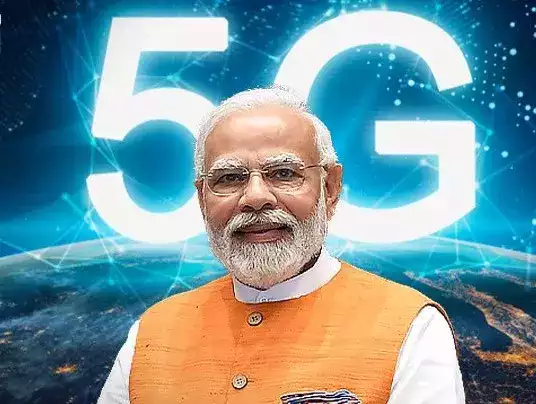The world is on the brink of a technological revolution, and India is not lagging behind. In fact, it has taken a significant leap in this direction as Prime Minister Narendra Modi launched 5G Technology in India according to rajkotupdates.news:a-historic-day-for-21st-century-india-pm-modi-launched-5g-in-india. This historic day marks the beginning of a new era that promises to transform the way we live, work and connect with each other. The introduction of 5G technology in India has been long-awaited and much-anticipated by millions around the country. So let’s delve into what exactly 5G Technology is and how its advancements are set to benefit India!
What is 5G Technology?
5G technology is the latest and most advanced mobile network technology available today. It is an upgrade from the previous 4G LTE standard, providing faster download and upload speeds with lower latency. The term “5G” stands for fifth-generation wireless technology.
Unlike its predecessor, 5G networks use higher frequency radio waves that allow data to be transmitted at much faster speeds, up to 20 times faster than 4G. This means that users can download large files quickly, stream videos in high definition without buffering, and play online games seamlessly without any lag.
But it’s not just about speed – 5G also promises to revolutionize various industries such as healthcare, transportation, education and more by enabling new applications such as remote surgery or self-driving cars.
To achieve these advancements, several different types of technologies are being developed including mmWave (millimeter wave), sub-6GHz spectrum bands and small cells among others. These technologies work together to provide a seamless experience for users while unlocking the potential of next-gen applications through enhanced connectivity.
The Different Types of 5G Technology
There are two main types of 5G technology: sub-6 GHz and mmWave. Sub-6 GHz is the more common type, which operates at frequencies below 6 GHz and provides a wider coverage area.
On the other hand, mmWave operates at higher frequencies above 24 GHz, providing faster internet speeds but with a shorter range. This means that it requires more cell sites to be installed for effective coverage.
Another type of 5G technology is called “low-band” or “mid-band,” which falls between sub-6GHz and mmWave in terms of frequency range. Low-band offers better coverage than mmWave but slower speeds compared to both sub-6GHz and mmWave.
Each type of 5G technology has its own unique benefits, making it important for telecommunication companies to choose the right one based on their network needs and infrastructure availability.
These different types of 5G technologies offer varying levels of speed and coverage areas that will allow users to have a seamless experience while using their devices on the go.
The Benefits of 5G Technology
The benefits of 5G technology are numerous and far-reaching, offering a significant improvement over the current 4G networks. First and foremost, 5G technology promises lightning-fast internet speeds that can reach up to 20 times faster than the current speeds.
This speed improvement will revolutionize many industries such as healthcare, education, transportation, entertainment and more. For example, remote surgeries with real-time feedback from doctors could become common practice thanks to reliable high-speed connections. Online learning experiences could be enhanced by allowing seamless streaming of videos and interactive real-time discussions.
Moreover, self-driving cars would also benefit from this network’s low latency which ensures immediate responses in traffic situations. Additionally, communication between devices will become much smoother using the Internet of Things (IoT) system as all connected devices will work together seamlessly on the same network.
Finally yet importantly is energy conservation through smart cities’ infrastructures that use sensors for managing lighting systems in public places based on actual needs instead of traditional time-based schedules.
In short, these benefits are just scratching the surface when it comes to what we can expect from this groundbreaking technology – there’s no doubt that 5G is set to change our world like never before!
The Advancements of 5G Technology in India
5G technology has made significant advancements in India over the past few years, with several telecom companies investing heavily in this area. One of the primary advantages of 5G is that it can offer faster internet speeds and lower latency than its predecessors.
The rollout of 5G networks across India will enable various sectors to adopt new technologies, such as IoT devices, AI-powered applications and VR/AR experiences. This is because 5G’s high bandwidth capacity allows for more data to be transferred at a faster speed than ever before.
Moreover, 5G also promises to improve healthcare outcomes by enabling smart healthcare solutions like remote patient monitoring, telemedicine services and electronic health records (EHRs). Additionally, it can enhance public safety measures through connected vehicles and traffic management systems that rely on real-time data exchange.
Furthermore, Indian businesses are expected to benefit from 5G technology due to reduced operational costs resulting from increased automation capabilities enabled by advanced technologies like robotics process automation (RPA).
These advancements in 5G technology are set to revolutionize different aspects of life in India by significantly enhancing connectivity capabilities while improving overall quality of life.
How 5G Technology will Benefit India
5G technology is expected to transform the way we interact with our devices and each other. India, being a technologically advanced nation, is looking forward to reaping the benefits of 5G technology. The introduction of this revolutionary technology in India will bring about numerous benefits.
Firstly, 5G networks are much faster than their predecessors. This means that data can be transmitted at a lightning-fast speed, making it possible for people to access information quickly and efficiently. As a result, businesses will be able to provide better services and customer experiences.
Secondly, 5G has lower latency which means there is less delay in transmitting data from one device to another. This feature will make it easier for remote workers and students who require high-speed connectivity to complete their tasks efficiently without any lagging issues.
Thirdly, 5G networks have higher bandwidth capacity which translates into more reliable connections even when multiple devices are connected simultaneously. This feature will help boost productivity and efficiency across various industries such as healthcare where telemedicine appointments could become mainstream.
Implementing 5G in India would create job opportunities across different sectors such as telecommunications engineering or software development companies requiring experts in 5G network deployment among others.
The implementation of 5G technology promises numerous benefits for India including faster speeds, lower latency rates leading to efficient communication between machines along with increased reliability which ensures uninterrupted service availability essential for businesses seeking growth opportunities through digital transformation processes.
Conclusion
The introduction of 5G technology in India is a significant step towards the future according to rajkotupdates.news:a-historic-day-for-21st-century-india-pm-modi-launched-5g-in-india. With its ultra-fast speed and low latency, it will revolutionize various sectors including healthcare, education, entertainment, and transportation. The advancements in 5G technology will lead to new opportunities for businesses and bring about improvements to people’s lives.
The launch of 5G by PM Modi marks a historic day for India as it joins other countries already reaping benefits from this cutting-edge technology. As we move into a more connected future where the internet plays an increasingly vital role in our daily lives, 5G is set to become an integral part of that landscape.
India has always been at the forefront of technological innovation and with the introduction of 5G; it is poised to take another giant leap forward. It’s now up to us as citizens and business owners alike to embrace this new technology fully and leverage its power for good.




